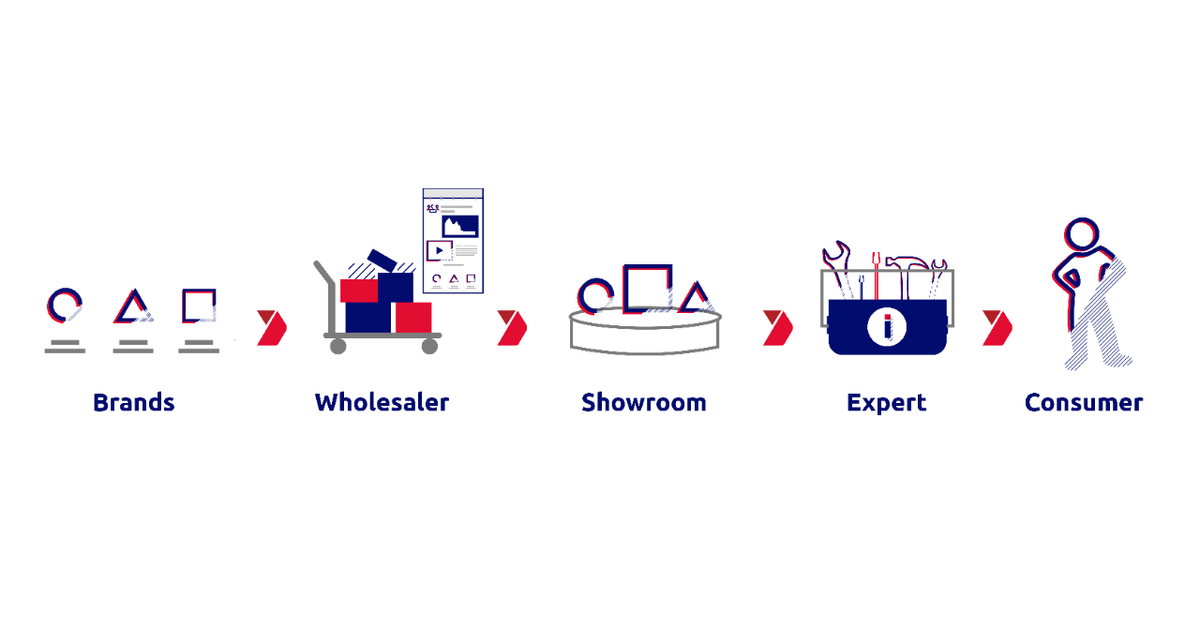Three tips to strengthen your chain position as the middleman
Within most sectors, companies are looking to find or claim their position within the value chain. The questions that arise in this process include:
What is the role of the middleman (wholesalers & retailers) now that more and more manufacturers are trading directly?
What will the role of the manufacturer be now that they are increasing direct contact with the end user?
Will you, for example, be buying a house from an estate agent or directly from a construction company in the near future?
One thing is certain: you must be able to clearly state your role in the chain at all times.
We have gathered some insights on what we have learned from technical wholesalers, and we believe they apply to other wholesalers too. Read our 3 main tips on how you can strengthen your position in the value chain.

Above image represents the value chain from brand to consumer with the wholesaler in the middle.
Now, let's dive into the three tips.
Three tips to strengthen your chain position as the middleman
1: Make your content user-centric
Your customer does not want to purchase a product, they are looking for a solution to a certain problem. As a technical wholesaler, you cannot stand out with a product alone - no matter how niche your sector is. You need to distinguish yourself by clearly communicating your knowledge and services as well.
By combining your product with your services and expertise, you can show how you differ from your competition. It is essential to position yourself as the expert in your field and having a good content strategy is key to get there. Make sure your content strategy is consistent and omni-channel. Listen to your users and understand what they need to know in which part of their journey. Make sure that the examples you share are relatable so you can stand out in an over-saturated market.
2: Make your content unique to your position
Every party in the chain adds value relevant to the end-user in a different way. Producers know their products in detail and are experts about your specific situation. As a wholesaler, for example, it is not necessary to describe a product in detail; the brand can probably do this much better itself. What is important to describe, however, is how a specific product works or can be used with other, similar or complementary products. To offer the perfect solution to the end-user, you have to work together with relevant chain players. By doing so, you avoid duplicate content. And the brand association your organisation receives by working on a user story with a brand is invaluable!
So, create content that is unique to your position in the chain, provide a solution for the ultimate end-user and avoid writing or doing what your competitors are already covering. In addition, everyone must be able to understand it, so enter into a dialogue with your user, preferably a local one. International dreamy inspiration stories are great, but can your users truly relate? As an example, you can read here how Technische Unie focuses on relevant and unique content for its users, and how iDA assisted them in this process.
3: Make your content strategic
To be relevant in the value chain and to maintain - or strengthen - your commercial position, you need to have a good content strategy so customers simply cannot ignore you. Ultimately, it is your goal to showcase your added value and to be top of mind with your customers so that they will choose your organisation over the manufacturer.
Having a content strategy is great because it maps out a clear roadmap of what you want your users to find value in. But you also want to maintain some flexibility so that you can instantly respond to any new wishes of the end-user and any changing market trends. Having an easy and responsive platform helps to quickly adapt and react, and it allows your organisation to develop attractive, consistent and content-rich web pages without IT intervention. As a result: you will develop an excellent customer experience that will leave consumers satisfied and returning.
D2C commerce (Direct-to-Consumer ) is a strategy that brands and suppliers are increasingly adopting. Manufacturers have already started to digitise their products and to sell them directly to consumers. This poses a threat to middlemen. The solution is to focus on content strategy and systems to regain and increase your market position. The right consumers should encounter your message and content at the most ideal moment, so that they consider you rather than the manufacturer itself.
This is one of the main pillars we, at IDA, focus on. We want to enable our customers to provide meaningful experiences that move their consumers.
Ready to take your next step?
Our sales team is always ready to discuss a challenge you are currently struggling with and see how we can help you come up with a solution. We have an in-depth knowledge and years of experience with the Adobe platforms so get in touch and we'll happily help you build a more scaleable, adaptable and personalised experience for your customers.
